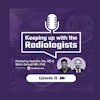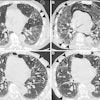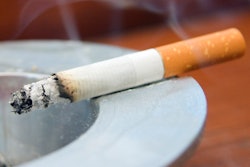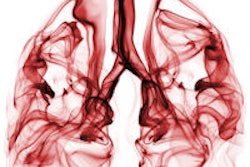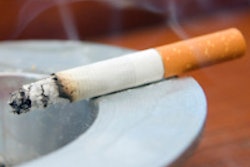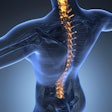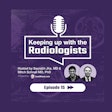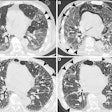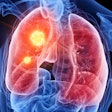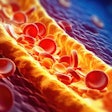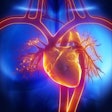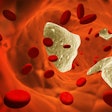
Almost half of patients at high risk for lung cancer didn't get timely follow-up after chest CT found potential problems that radiologists flagged on their scans, concludes a new study in the May edition of the Journal of the American College of Radiology.
Researchers from Massachusetts General Hospital retrospectively reviewed the records of symptomatic patients who received diagnostic chest CT scans in 2012 and had recommendations for follow-up, most commonly for a lung nodule. While most patients eventually saw a physician, just more than half received timely follow-up.
"Although most received follow-up, only 55% of patients had follow-up performed within the recommended time frame," wrote lead author Dr. Sanja Percac-Lima, PhD, and colleagues (JACR, May 2016, Vol. 13:5, pp. 497-504).
Tough road to early detection
Just five years have passed since the goal of identifying lung cancers at an early, curable stage proved feasible, and the U.S. agreed to pay for screening only a year and a half ago. The National Lung Screening Trial (NLST), published in 2011, found at least a 20% mortality benefit from screening, a figure that relied on timely follow-up for its success.
Whether or not patients can expect timely follow-up in 2016 is unknown, however. Two recently published studies showed wide variation in follow-up rates, with about 8% to 53% of patients not receiving recommended follow-up of incidental nodules. But neither study focused on smokers at high risk of developing lung cancer, according to the authors.
"To better anticipate the challenge of ensuring appropriate follow-up after any abnormal screening chest CT finding, we sought to examine adherence to follow-up recommendations after a diagnostic chest CT that was performed as part of a clinical evaluation among patients likely to be eligible for lung cancer screening," Percac-Lima and colleagues wrote.
The primary goal of the study was to measure the percentage of patients who received timely follow-up after an abnormal chest CT scan. The researchers defined timely follow-up as the patient receiving the suggested test within 30 days of the time period recommended by the radiologist. Percac-Lima and colleagues also examined factors associated with why recommendations weren't followed up in a timely fashion.
Reviewing chest CTs
The study encompassed individuals seen at 19 primary care practices associated with Massachusetts General Hospital in Boston, and included current smokers between the ages of 55 and 79 years who had received a primary chest CT to evaluate symptoms during 2012.
All CT images were acquired in a single hospital-based radiology practice, and they were interpreted by experienced thoracic radiologists who based follow-up recommendations for pulmonary nodules on Fleischner recommendations. Data on patient characteristics such as age, gender, insurance status, ethnicity, and practice site were collected for the study. The investigators also looked at referral indication, and whether the encounter was a primary office visit, urgent care, etc.
Among 3,257 current smokers at high risk for developing lung cancer in the study network, 446 (13.7%) had diagnostic chest CT scans during 2012. After excluding 70 patients due to death, existing lung cancer diagnosis, or for having left the network, 376 subjects (mean age, 64.9 years) remained. Of these 376 subjects, 51.3% were women, 94.9% spoke English, 90% were white, and 16.8% had Medicaid or no medical insurance, the authors wrote.
The most common indication for chest CT was the presence of a nodule and/or abnormal prior imaging, followed by nonlung cancer malignancy. One-third of the chest CT scans were performed because of nonpulmonary causes or possible infection.
Out of the 376 patients, 337 (90%) had an abnormality noted on the baseline chest CT. The most common abnormal finding was a reported nodule (63.3%), with suspicion for a malignancy noted in 28 (7.5%). Other pulmonary disease, such as chronic obstructive pulmonary disease and emphysema, was identified in 26.6% of patients, and a suspected infectious etiology was found in 12.2%.
Usually a nodule
Among the 337 patients with an abnormal chest CT finding, 184 (55%) had a recommendation that an imaging or biopsy follow-up be performed within a certain time period, ranging from 30 to 365 days (mean, 177 days). By far the most common abnormal result that required follow-up was a nodule on chest CT, in 91.9% of patients.
Out of the 184 patients with recommendations for follow-up, 102 (55%) received them within the recommended time frame. Meanwhile, 63 patients (34%) received follow-up CT outside of the recommended time frame, and 19 (10%) did not have a recommended follow-up CT at all.
"Our study revealed that 90% of the chest CTs performed in high-risk patients had an abnormal finding, and 50% required follow-up," Percac-Lima and colleagues wrote. "Although most received follow-up, only 55% of patients had follow-up performed within the recommended time frame."
Fortunately, timely follow-up rates were higher for patients who were eventually identified as having a newly diagnosed lung cancer: 67% had their first oncology visit within 30 days of their diagnosis, the authors reported.
Patients were more likely to have their follow-up in a timely manner if the CT indication was pulmonary disease. This category constituted 80.6% of all patients with timely follow-up, compared with 52% of patients without pulmonary indications.
Patients receiving care in a community health center were more likely (68%) than those from other types of facilities (46%) to have timely follow-up. Several factors such as race, insurance status, order site, or the time frame recommended for follow-up had no effect on timeliness of care.
Limitations of the study included its single-center design and the lack of some patient details such as the number of pack-years smoked, meaning that some of the patients may not have been eligible for low-dose CT (LDCT) lung cancer screening, the authors noted.
"The widespread implementation of lung cancer screening with LDCT imaging will require interval follow-up studies and adherence with continued annual screening studies," they wrote.
More than one-fourth of patients in the National Lung Screening Trial required additional testing, meaning that more follow-up will be needed. Still, twice as many CT scans in the current study required follow-up compared with NLST.
"As we plan to broadly implement lung cancer screening in usual clinical practice, developing systems with resources to aid patients, and ordering physicians through the follow-up process, is imperative," they wrote.
This means selecting patients who would likely benefit most from lung cancer screening, a process that includes assessing comorbidities.

